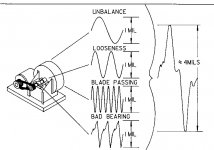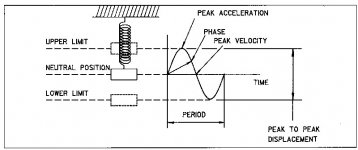So related to that a tech told me that on the OKUMA M560v they have what he said was a microphone that picks up squeely noises, and then has the capability to induce this slow sinusoidal modulation to smooth out the chatter.
Chatter produced by milling vs. turning respond differently. Milling chatter must first be addressed through part/setup rigidity, then through depth/width of cut, and then by spindle-speed & chip-load. But anyway, If you're lucky enough to be at the spindle-speed & chip-load level, then chatter is suppressed by making a single change to a new spindle-speed and/or chip-load.
No oscillations when suppressing milling chatter... Ypu need a constant change.
With turning, the first level is still part/setup rigidity, then less importance on depth of cut & feed, and finally, very little difference with regards to spindle/cutting speed. The difference is, that chatter when turning is much more finicky, and
you do suppress it through oscillating the spindle speed. A constant change just means changing the frequency of the chatter - it's only suppressed/broken-up through oscillating the
spindle speed. On older, low-tech lathes, that means jogging the spindle-speeds up and down manually via the overrides - which generally means 10% increments, typically 2-3 times a second, because that's the increments of the overrides, and the speed of your hands...

Where the modern machines make better use of this oscillating speed principle, is that you can alter the parameters of the oscillations - meaning you can define the frequency & amplitude of the oscillations, which probably means better response from the cut, and better luck in actually suppressing the chatter than what was previously possible using your two hands and the overrides...
---------------------------------------------
Regarding an objective measure to rigidity...
In terms of chatter, it gets messy. In some applications - particularly boring on a lathe - you can actually be
too rigid... Case in point - We have a new Mazak lathe, and I was having trouble with chatter in a boring operation, despite the machine being new & tight, with it's pre-loaded linear-roller guides. Having a rigid tool, in a decent holder & pinch-sleeve, and good workholding/part-rigidity, I was still fighting chatter... The answer? Electrical tape. No, seriously.... I pulled the tool-holder off, put a layer of electrical tape between the mounting surfaces, and tried again. Viola! Silence...
Weather it was the actual harmonic-dampening effects, or the slight deflection of the tool under load at work, I'm not sure, but it worked. I wonder to myself, if this machine was a box-way machine with turcite on the sliding elements, if this chatter would have never been an issue. So, at some level, a little dampening/deflection makes a difference...
------------------------------------------
From another perspective though, one could quite easily & objectively measure the effective "rigidity" of a machine using an indicator, and "forcing" the machine's axes into a solid object. Simply find out how much thrust each axis has under 100% load. Bolt a solid object to the table/chuck, and force each axis *gently* into the object. Use a test-indicator to measure the deflection...
Here's a cool video of the Binns "Super-Lathe" that talks a little bit about rigidity... Even if it doesn't help address your concerns of objective rigidity, it's a cool video nonetheless... 23 minutes long, but definitely worth it...
 https://youtu.be/j87WW-jGmrU
https://youtu.be/j87WW-jGmrU


 I will learn.
I will learn.




